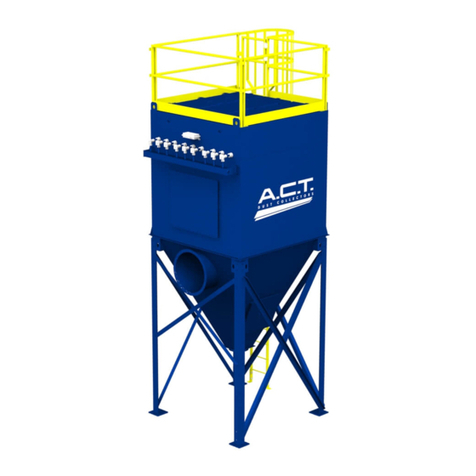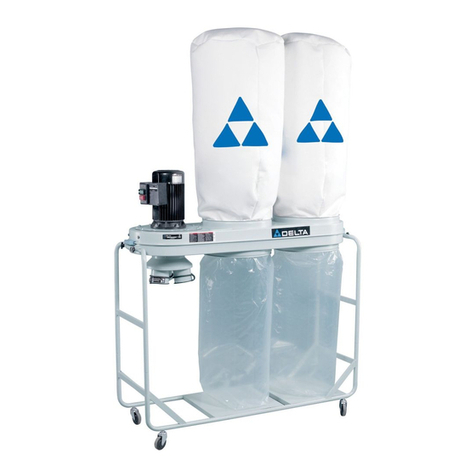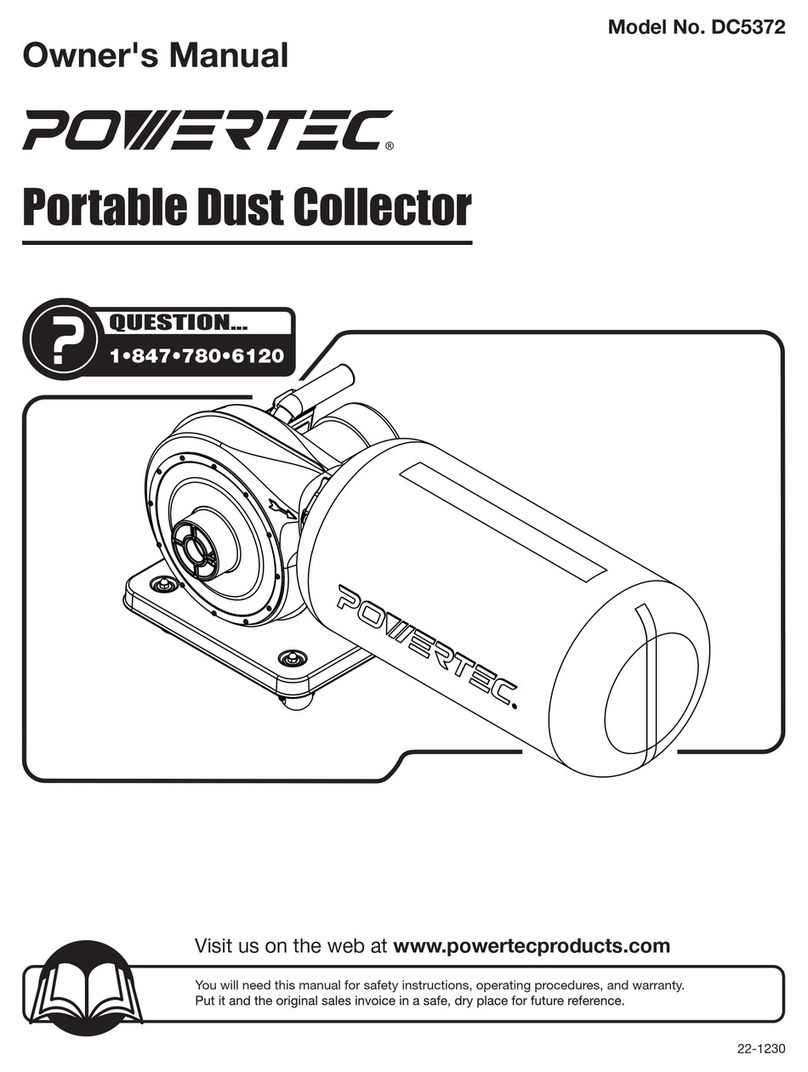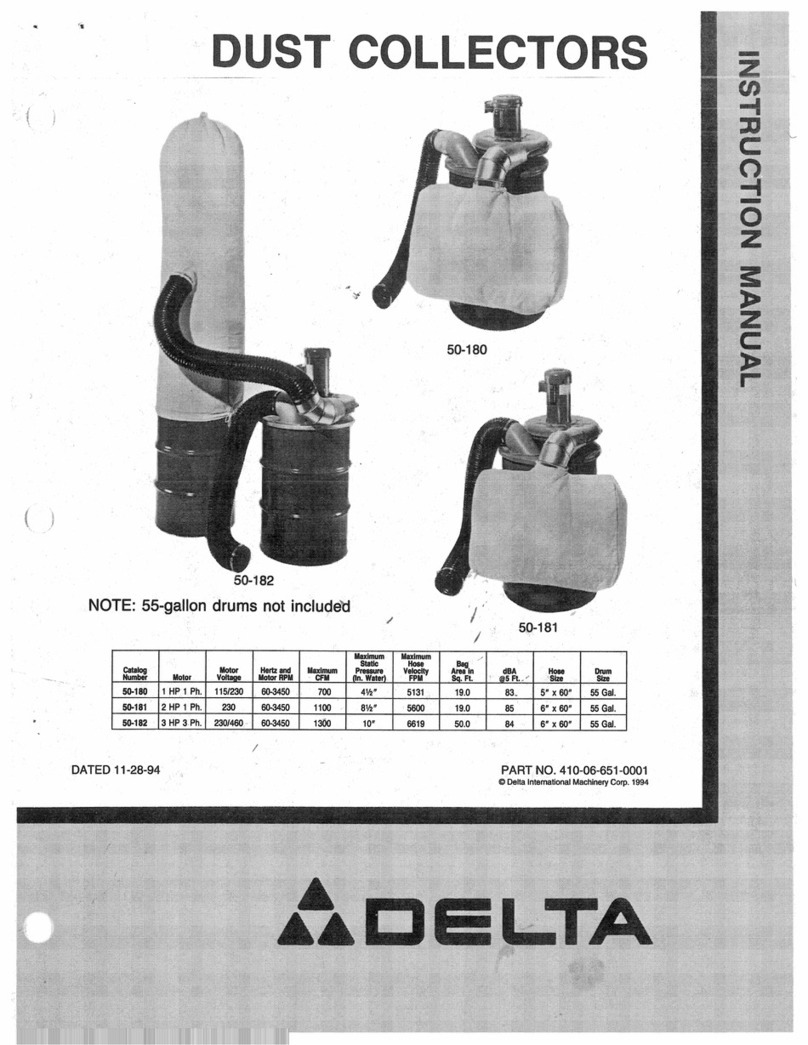ACT LASERPACK User manual

IOM-101.1 v2
LASERPACK
Installation and Operation Manual

2
ACT Dust Collectors
CAUTION!
Accidents happen, be careful and always follow all local and federal regulations!
Fires and explosions do occur in dust collectors. Many items in a dust form can become very flammable and/or
explosive. It is very important that when installing a dust collector to check with and abide by all local and federal
regulations. Precautions such as spark traps, detectors, and extinguishers are always recommended when sparks or
explosive danger is present. Never throw any burning objects into the duct work or dust collector. There is no way to
guarantee 100% prevention of fires. However, the methods mentioned above will greatly reduce your risk. ACT
Dust Collectors will not be responsible in any way for any loss or damage associated with fires or explosions in your
dust collector.
If your dust collector came with explosion vents or if explosive dusts are present, it is the owner’s/operator’s
responsibility for full compliance with all authorities having jurisdiction. It is recommended that the NFPA codes be
studied and applied, including, but not limited to 68, 69 and 654. Included in the NFPA standards is the issue of
isolating your dust collector. Please contact us or an expert in the area regarding isolation of your dust collector in
the event of an explosion. Unless a Kst test was performed, and we were provided with the results, the size of the
explosion vents may be inaccurate and you may not be in compliance. It is the owner/operators responsibility to
verify the Kst and Pmax values. We recommend that your process be evaluated regularly to make sure that you
remain in compliance and the vent area is sufficient. ACT Dust Collectors will not be responsible for ANY loss
whatsoever resulting from an explosion associated with an ACT dust collector.
Dust collectors are tall and top heavy. Always be careful when handling them. Make sure your equipment is capable
of making the lifts and moves you are trying to make. Be sure the foundation for the dust collector is proper and
secure.
All plumbing and electrical should be performed by certified professionals and meet all codes and regulations.
Never open any doors or access panels while the machine is in operation.
Always shut down the unit prior to service and lock out all disconnects.
Always wear proper safety equipment when working on or around your dust collector and follow all local and federal
codes.
Dust Collector
Model: _____________________________________ Serial Number: _________________________________
Filters: _____________________________________ Ship Date:_____________________________________
Option/Accessories: __________________________________________________________________________
Fan Blower
Manufacturer/Model: __________________________ Serial Number _________________________________
Product Datasheet

3
ACT Cartridge Dust Collector
Table of Contents
Introduction................................................................................................................................................................. 4
Operation Principle..................................................................................................................................................... 5
Shipping and Receiving ............................................................................................................................................. 6
Handling ..................................................................................................................................................................... 6
Assembly
Dust Collector Anchoring .............................................................................................................................. 7
Compressed Air ............................................................................................................................................ 7
Electrical..................................................................................................................................................................... 8
Timer Board Programming......................................................................................................................................... 9
Maintenance
Filter Replacement ...................................................................................................................................... 12
Spark Trap Cleaning ................................................................................................................................... 13
Bag-in Bag-out Collars ................................................................................................................................ 14
Troubleshooting ....................................................................................................................................................... 15
Warranty................................................................................................................................................................... 17

4
ACT Dust Collectors
Introduction
Thank you for your purchase of an ACT dust collector. Our goal is to provide you with a product of best quality,
service, and pricing in the industry.
This manual is to provide general instructions in assisting you with your installation, operation, and maintenance of
your equipment. It is the user’s responsibility to ensure that the equipment is correctly installed and operated. It is
also the user’s responsibility to ensure and provide qualified personnel for the installation, operation, and
maintenance of the equipment and to adhere to all applicable federal and local building and safety codes and
regulations.
Any special instructions and certified drawings accompanying this equipment shall supersede this manual.
Keep this manual along with any special instructions and drawings necessary for assembly, operation, and
maintenance with the equipment.

5
ACT Cartridge Dust Collector
Operation Principle
The ACT cartridge dust collector is a pulse-jet air cleaning device that removes the particulates from dust-laden air
and allows clean air to be exhausted. As dust enters through the dirty air inlet it passes through the cyclonic spark
trap, the heavy particulate is then directed towards the drawers while the remaining fine dust is collected on the
cartridge filter surface, allowing clean air to be exhausted back into the atmosphere.
To remove excess dust buildup on the filters, a timer board is used to sequentially open the diaphragm valves and
release a pulse of compressed air. This venturi-assisted pressure pulse releases the accumulated dusts from the
filters, allowing the particulate to drop down into the drawers.
Dirty Air Inlet
(not shown)
Filtered Dust
Drawers
Dust Filtration Process
&
Pulse-Jet Cleaning Process
ACT Nano-Elite
Premium Cartridges
Clean Air Outlet
(Ambient)
Downward Airflow
Internal
Spark Trap
Integrated
& Silenced Fan
Reverse Pulse-Jet Filter
Cleaning System

6
ACT Dust Collectors
Shipping and Receiving
All products from ACT Dust Collectors are carefully inspected for quality and order completion prior to shipment.
Prior to unloading, inspect all components for any shipping damage and missing parts. Report and file a claim
immediately with the carrier for any damage or missing items. Once filed, contact your ACT Dust Collectors
representative to notify them of your issue(s).
Any repairs to components with minor damage from transit must be approved in writing by the manufacturer.
Handling
Handling should be performed by trained, able, and qualified personnel and be consistent with safe handling
practices outlined by OSHA and local codes.
Review this manual and any additionally supplied certified drawing(s) to familiarize yourself with the lift points of
each of the components.
Verify the integrity and lift capacity of all handling equipment/components.
When handling the housing, it is recommended to utilize spreader bars to prevent any deformation during lifting.
All lifting points are to be used.
Table 1 - Recommended SAE Torque Table
Bolt Size SAE Grade 5 Torque (ft-lb), dry
1/4-20 8.4
5/16-18 17.4
3/8-16 31
7/16-14 49
1/2-13 75
5/8-11 150
3/4-10 267

7
ACT Cartridge Dust Collector
Assembly
Dust Collector Anchoring
Install 3/8 inch diameter anchor bolts with a minimum of 3
inches into the foundation. Ensure foundation complies with all
local regulations and codes
Use recommended SAE torque table for the anchor bolts.
Compressed Air
The supplied compressed air must be clean, dry, and oil-
free. Set the compressed air pressure levels to 80-90
psi. Do NOT exceed 100 psi as damage may occur to
the components.
Prior to installation, purge the compressed air lines of
any dirt or buildup.
1. Install the compressed air pipe line to the air
manifold to either the top or bottom 1” NPT coupling.
Use thread sealant tape or compound on all
connections.
2. A drip tee or ball valve installed on the bottom of the
manifold is recommended to allow for the draining of
any water buildup.
3. It is also recommended to install a shut-off valve,
pressure regulator, safety exhaust valve, and filter
close to the collector.
1” NPT Female Coupling
Plastic Tubing
Air Manifold (Header)
Diaphragm Valve
Solenoid Valves
1” NPT Female Coupling

8
ACT Cartridge Dust Collector
Clean Air Side
Low Pressure Side = –
Dirty Air Side
High Pressure Side = +
Electrical
All wiring but main power lines will be assembled by ACT. In the case of maintenance or repair, refer to below
instructions.
Refer to nameplate in control panel for proper supply voltage.
Refer to page 9 for recommended timer board settings.
———————————————————————————————————————————————————-
All wiring should be done by a certified electrician and in accordance with all local and federal codes.
Refer to the job specific electrical drawing(s) located in the panel and manual binder for detailed instructions.
Fan and timing board/solenoid wiring are to be in separate conduits.
See diagram on page 10 for 5 HP fan wiring
See diagram on page 11 for 10 HP fan wiring
1. Fan
Verify fan rotation by observing from the motor end. Another indication is poor fan performance or a
lack of air movement.
2. Control Panel
The timer board is located inside the control box, mounted on the dust collector.
Once the timer board has been installed, the pressure gauge must be connected to the dust collector
using customer supplied ¼” tubing (see figure below for low and high pressure ports). If the dust
collector is installed outside, the tubing should UV resistant.
IMPORTANT: Prior to operating the dust collector or adjusting the settings, ensure that the
down time clean feature has been properly wired. This feature will allow the dust collector to clean itself
during shut down, which will aid in prolonging the life of the filters.
Control Box

9
ACT Dust Collectors
Timer Board Programming
Familiarize yourself with the timer board manual before programming the timer board.
The table below summarizes the recommended settings. Consult with ACT Dust Collectors for specific applications.
Table – Recommended Timer Board Settings
Feature Settings
Process Current pressure drop
Last Output
The highest output terminal value that has a wire installed in it. Terminal
outputs have a range from 1-22 and are found near the bottom of the timer
board.
Time Off 10
Time On 100
High Limit 1.00” above initial pressure drop
(Contact Manufacturer for Questions)
Low Limit Starting value of 1” below high limit value
High Alarm 10 (Unless alarm is installed - Consult Manufacturing)
Low Alarm 0 (Unless alarm is installed - Consult Manufacturing)
Cycle Delay 0
Down Time Cycles 10
Auto Alarm Reset Unless notified, leave at factory setting of 5.

10
ACT Dust Collectors
WIRING DIAGRAM—5 HP

11
ACT Dust Collectors
WIRING DIAGRAM—10 HP

12
ACT Cartridge Dust Collector
Gasket End
Cartridge
Filter
Filter
Access
Door
Maintenance
Cartridge Filter Replacement
1. Turn off the fan and wait until the down time cleaning
cycle is completed.
2. Lock out/ tag out power to the collector and fan.
3. Open the filter access door by pulling and lifting the
cam handle.
4. Once door is loose, lift it off the securing hooks and set
it down.
5. Reach into the collector and pull out all of the filters.
(Or work your way top down to avoid dust from the
upper filters falling down on to the new filters).
6. Once filters are removed, install new filters. Make sure
that the gasket end goes into the collector first.
7. Reinstall the filter access door.
Open
Close
Filter Access Door
(Opening and Closing)

13
ACT Dust Collectors
Maintenance
Spark Trap Cleaning
1. Turn off the fan and wait until the down time cleaning cycle is completed.
2. Lock out/ tag out power to the collector and fan.
3. Access the spark trap by unbolting the spark trap cover
4. Remove any debris or buildup inside of the spark trap.
5. Reinstall the spark trap cover.
*Amount of dust collected will vary across applications. Initially check spark trap once a week and adjust as
needed.
Spark Trap Cover

14
ACT Dust Collectors
Bag-In Bag-Out Collars (OPTIONAL)
Bag-in/bag-out collars are used when harmful dusts are present or simply to minimize exposure to any dust.
They minimize the amount of dust the operator comes in contact with by allowing the operator to replace the
filters by using a bag strapped onto the collar. Although this procedure does greatly reduce exposure to the
dusts, it is hard to completely avoid any exposure. It is strongly recommended that the operator still use
proper protective clothing, including respirators.
1. Remove the filter access cover and set it aside.
If you would like, you can use a bag for this
process to further minimize exposure. Starting
at the top row of the dust collector will prevent
dusts from falling on to new filters already
installed in the rows below.
2. Take a new bag and place it over the outside of
the bag collar. Secure the bag around the collar
with the provided strap. Securely tighten the
strap.
3. Grab the bottom of the bag, reach in and twist
the filter to drop off any dust that may be in the
pleats of the filter, and then pull the filter out into
the bag.
4. Before removing the bag from the collar, it is
recommended that you twist the bag to prevent
the dust from escaping and use a tie to seal off
the bag.
5. Remove the bag from the collar.
6. If there are two filters in your filter access hole,
repeat this process for the next filter.
7. Place the new filter into the filter access hole. To
further minimize exposure to dusts, this can be
done by first loading the new filter into a bag.
8. Replace the filter access door and continue this
process until all filters have been replaced.
Secure bag on to the collar
Reach in and grab the filter with the bag
Remove the filter while still inside of the bag

15
ACT Dust Collectors
Troubleshooting
Problem Probable Cause Solution
Poor performance - not enough
suction or air movement
Fan rotation in wrong direction Rewire three phase wires to
change fan rotation
Closed damper or obstruction in
airstream
Slowly open damper or remove
obstruction
VFD Verify settings and operating
speed
System design Verify fan performance to fan
curve with airflow, static pressure,
and amperage readings
Re-evaluate system design to
verify that the fan is properly sized
for the application or nothing has
changed since product selection
(i.e. added a new weld station)
System effects Check along the duct system to
ensure that there is no abrupt
changes in airflow (i.e. inlet box
with no turning vanes, mitered
elbow with no vanes, etc.)
Filters at end of life Replace filters
Not enough compressed air Verify that the pressure is high
enough for effective cleaning (set
to 80-90 psi)
High differential pressure Dirty filters Activate cleaning by reducing the
"high limit" or manually pulse by
following the instructions in timer
board manual
Replace filters near end of life
Not enough compressed air Verify that the pressure is high
enough for effective cleaning (set
to 90-100 psi)
Defective cleaning system Verify solenoids, diaphragm
valves, and timer board are
functioning and properly wired
Motor over-amping Fan design Overloading radial-bladed fans
may require a damper to reduce
the horsepower requirements
Electrical Verify correct motor supply voltage
Fan/motor sized incorrectly Confirm system requirements with
airflow measurements
Replace fan with larger unit

16
ACT Cartridge Dust Collector
Troubleshooting Continued
Problem Cause Solution
Zero differential pressure
reading
Wrong pressure high/low pressure
tubing connection
Swap the connections of the
pressure reading plastic tubing on
the side of the collector
Pressure reading tubing kink or
leakage
Inspect tubing for kinks or leakage
Filters/Bypass Verify filters are installed and that
there is no bypass of dust
Defective timer board Replace board. (1-800-422-1316)
Cleaning system not pulsing Solenoid Listen for clicking noise to verify
solenoids are opening/closing.
Replace if defective.
If located in frigid outdoors
temperatures, a solenoid heater
may be required
Diaphragm Valve Replace worn diaphragms.
(1-800-422-1316)
Timer board Manually pulse by following
instructions in timer board manual.
Verify it is correctly installed.
Defective. Replace board. (1-800-
422-1316)
No down-time cleaning Timer board Verify settings on timer board
Electrical Call A.C.T. to verify electrical
drawings and specifications.
(1-800-422-1316)
Dust discharging from outlet Filter damage Inspect filters for tears along filter
media and gaskets.
Filters installed incorrectly Verify that the filters are installed
correctly with gasket end towards
the collector.
Pulse pressure set too high Decrease compressed air
pressure.

17
ACT Dust Collectors
Warranty
Air Cleaning Technology, Inc. warrantees the equipment to be free from defects in materials and workmanship for a
period of 10 years from the date of purchase. This warranty does not cover any damage due to normal wear and
tear including, but not limited to, corrosion, abrasion, elements, and modifications. This warranty covers parts only.
This warranty covers only the parts manufactured exclusively for Air Cleaning Technology, Inc. All other parts will be
covered by individual manufacturer’s warranty.
For Questions and Replacement Parts
Call Toll-Free 800-422-1316

N
S
N
U
N
Table of contents
Other ACT Dust Collector manuals
Popular Dust Collector manuals by other brands
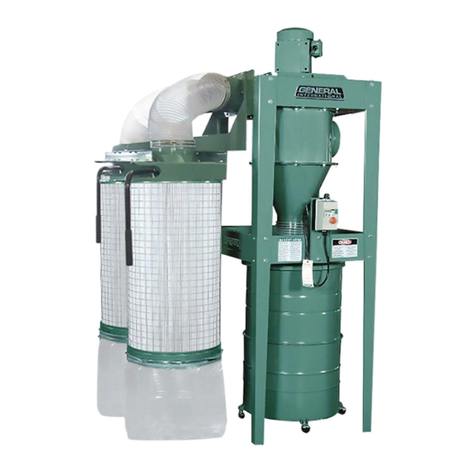
General
General 10-850CF Setup & operation manual
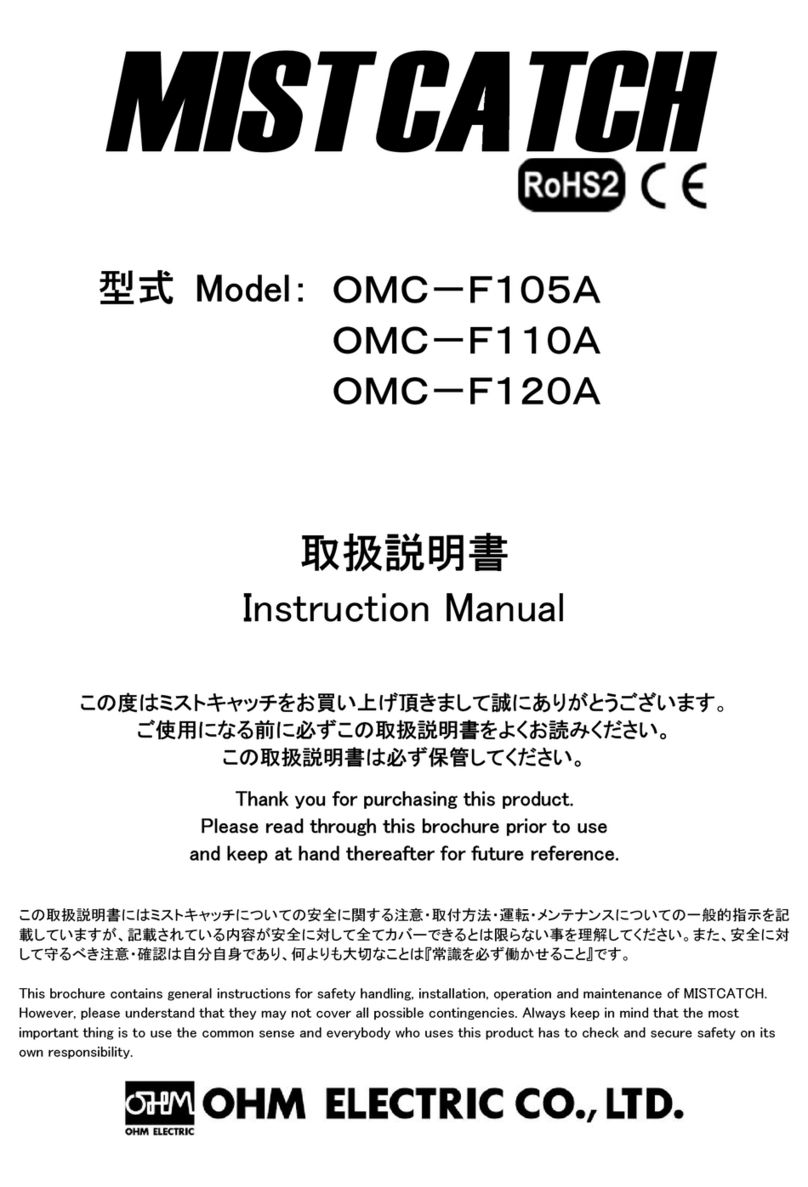
OHM ELECTRIC
OHM ELECTRIC MIST CATCH OMC-F105A instruction manual
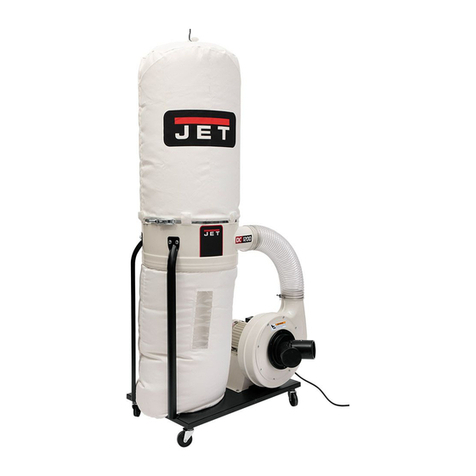
Jet
Jet DC-1200A Operating instructions and parts manual
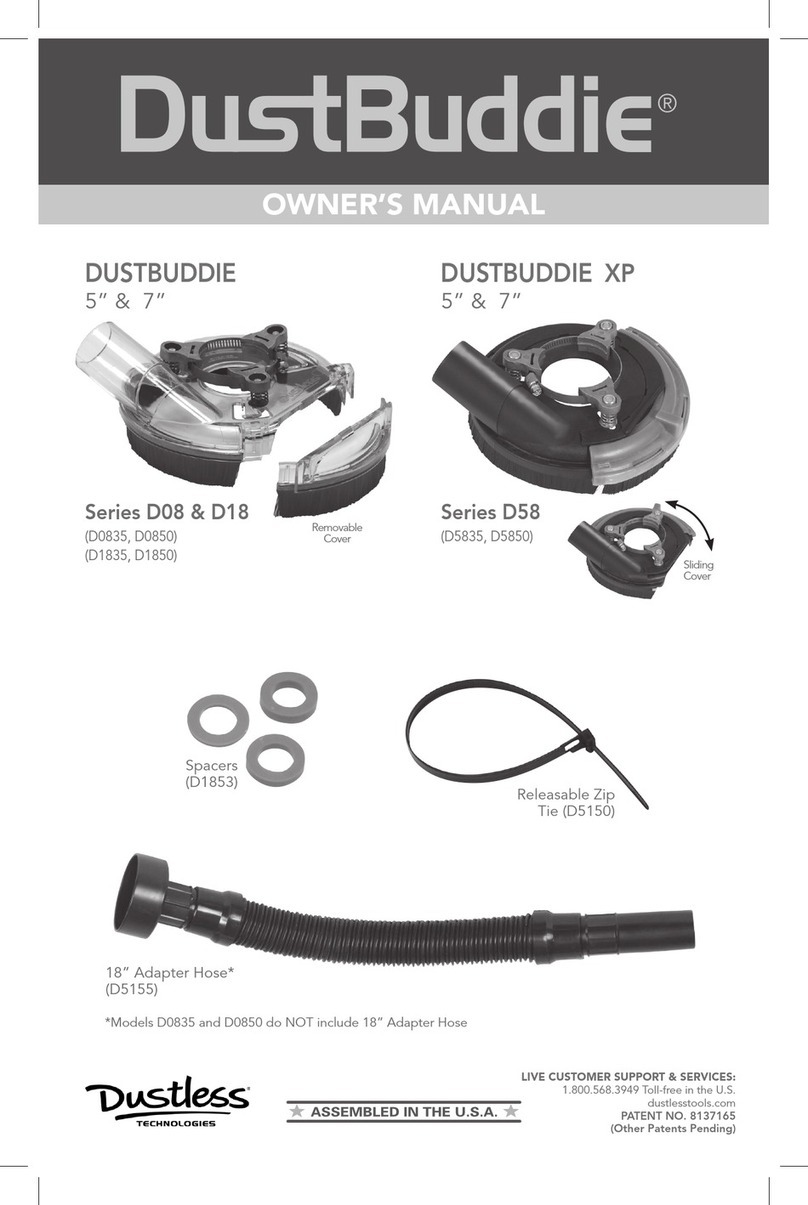
Dustless
Dustless DUSTBUDDIE D08 Series owner's manual
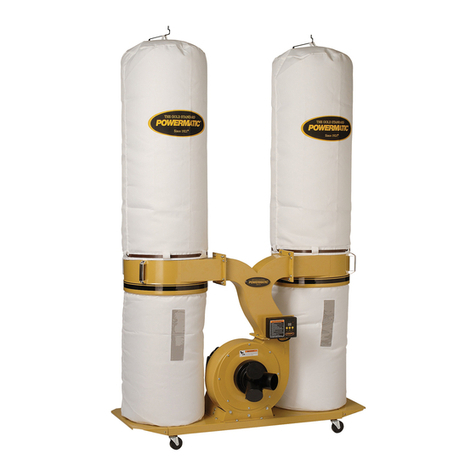
Powermatic
Powermatic PM1900TX Instructions and parts manual
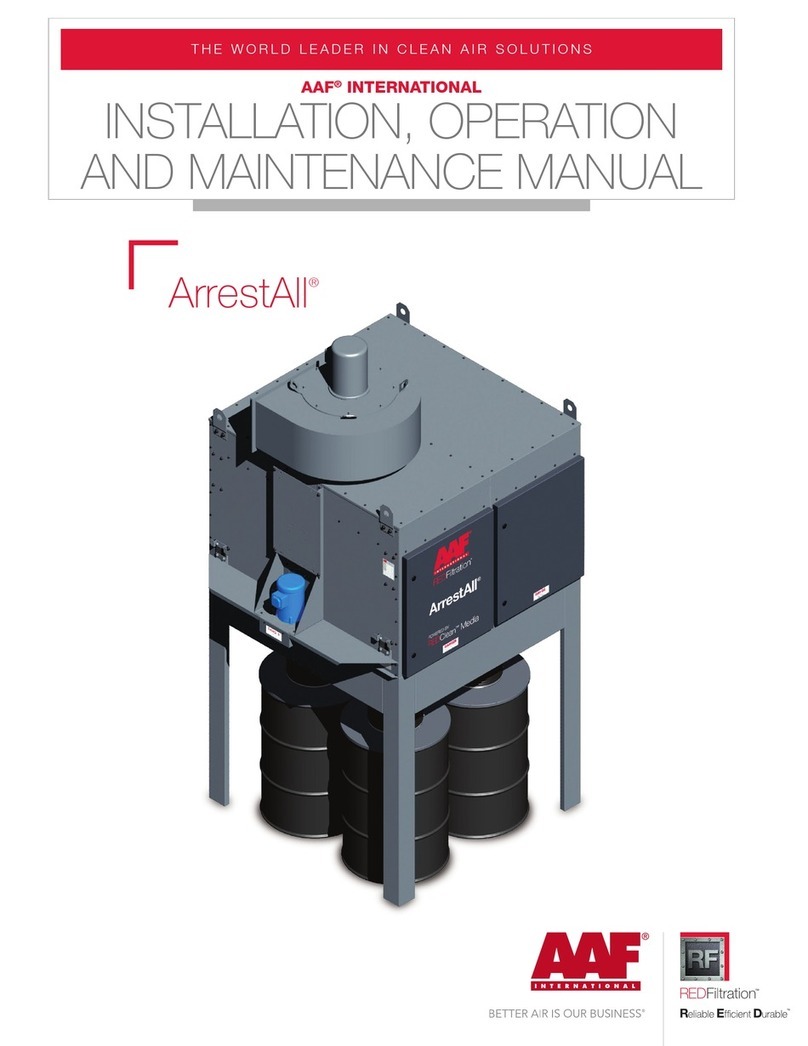
AAF
AAF ArrestAll AR 1-3 FB Installation, operation and maintenance manual
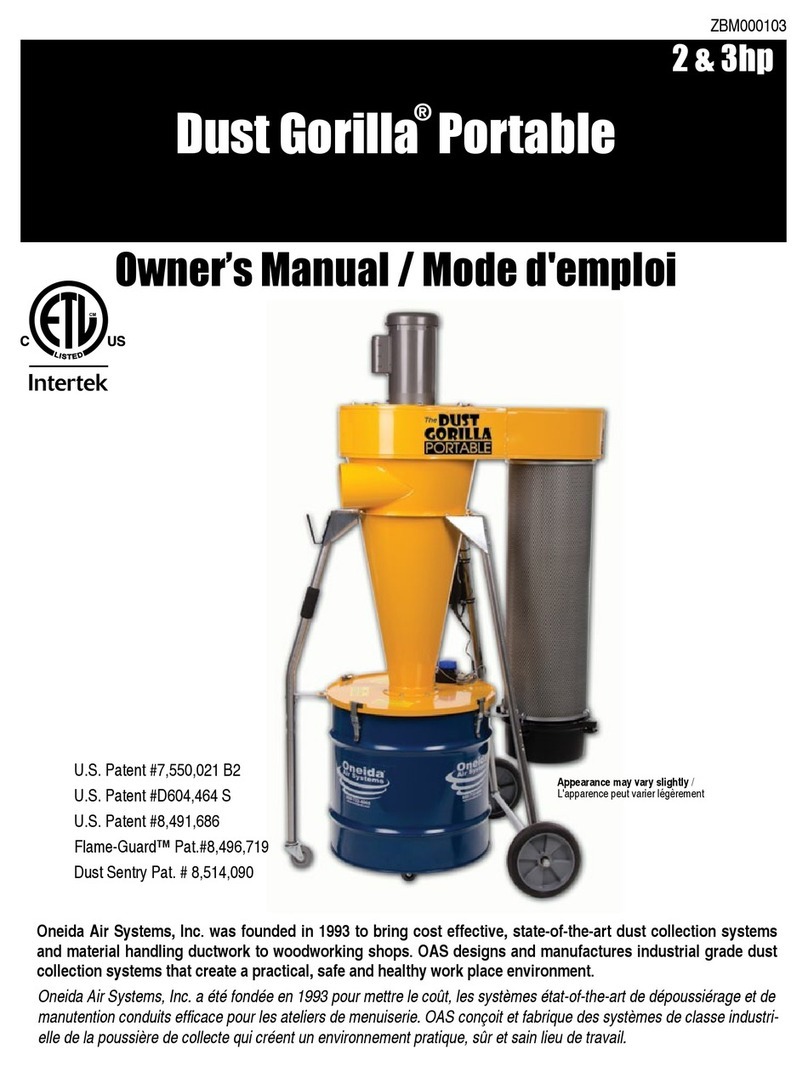
Oneida Air Systems
Oneida Air Systems Super Dust Gorilla owner's manual

Showa Denki
Showa Denki Chiko CKU-060AT3-ACC instruction manual

Timbecon
Timbecon DC2200 instruction manual
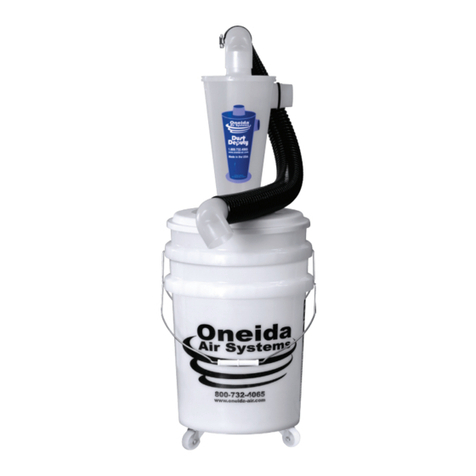
Oneida Air Systems
Oneida Air Systems Deluxe Dust Deputy manual
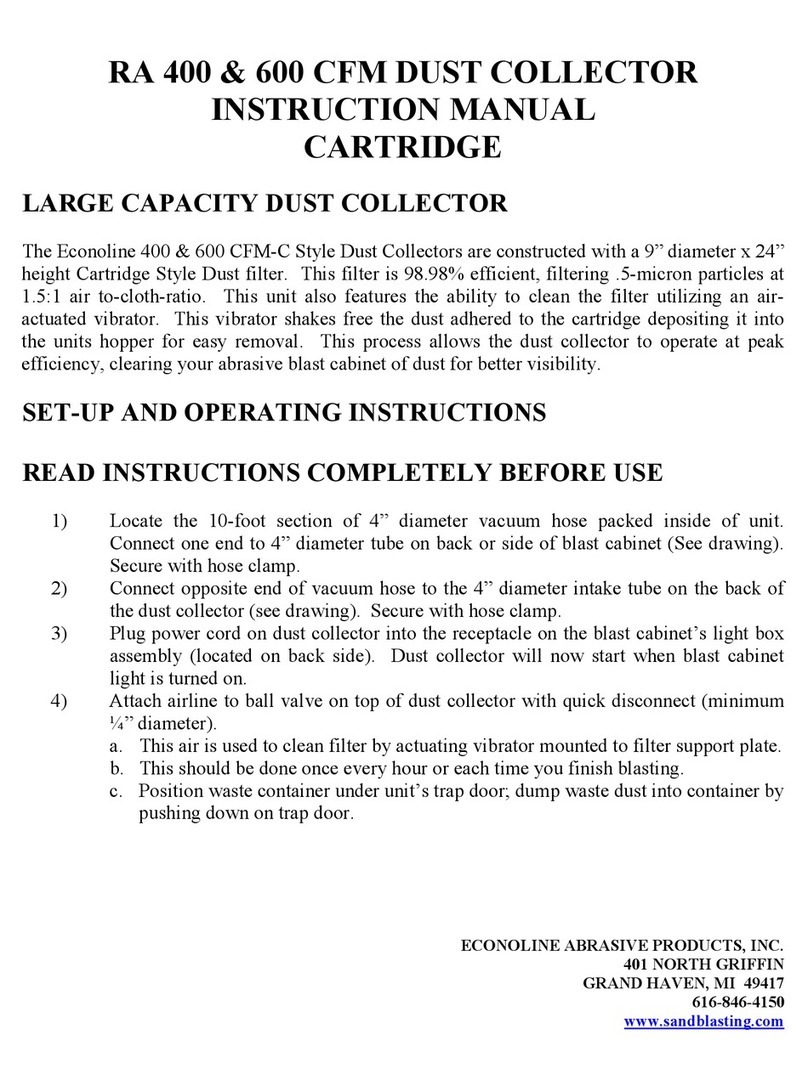
Econoline
Econoline RA 400 instruction manual
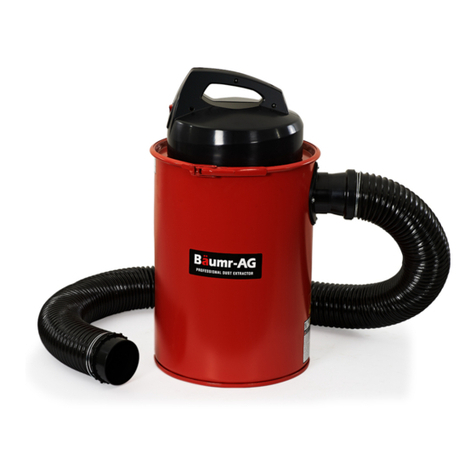
Baumr-AG
Baumr-AG BM-DD5 user manual
